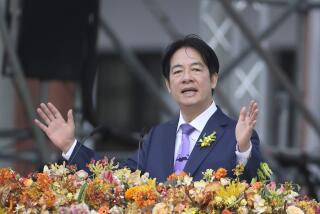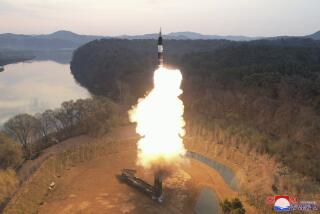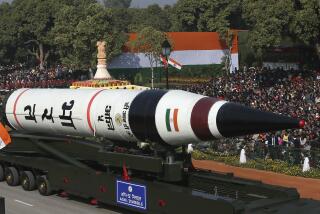Amid Tensions, China Tests New Missile
BEIJING — Amid U.S. allegations of espionage and during increased tensions with Taiwan--including stepped-up air maneuvers over the Taiwan Strait--China announced that it successfully conducted a test launch Monday of a new type of long-range missile.
A terse statement by the official New China News Agency confirmed the test-firing of the ground-to-ground missile within Chinese territory, but it gave no further details. The Ministry of National Defense declined to comment.
Although the type of weapon was not specified, international military experts have expected for months that Beijing would test its new Dongfeng-31 missile, which analysts say has a striking distance of about 5,000 miles. Deployment could begin within three years.
Monday’s announcement by Beijing, which normally keeps details of its military capabilities under wraps, comes on the heels of a similar statement last month officially confirming China’s ability to build a neutron bomb. Beijing is engaged in a noisy round of saber-rattling with neighboring Taiwan, whose president, Lee Teng-hui, recently incensed the mainland by redefining the relationship between the two rivals.
Lee has said that Taiwan and China should treat each other as equal states and abandon the “one China” formula that has underpinned relations between the two sides. Beijing rejects this new characterization and sees Taiwan as a rebel province to be retaken by force if necessary.
In an escalation of the tension, sources on both sides of the Taiwan Strait say, China and Taiwan have sent jet fighters on dozens of flights over the narrow waterway in the past few weeks, straying close to the dividing line between the two rivals.
A Taiwanese military official sought to downplay the increased activity, saying that “as long as you don’t cross over the line, it’s not a hostile maneuver.” But another official acknowledged that Taiwan had detected an increase in Chinese sorties over the strait--only 115 miles wide--and that the government in Taipei, the Taiwanese capital, had no choice but to respond.
“If they’re flying close to our side and pose a possible threat, how could we not react?” the official said. “For our own safety, we have to mount a response.”
He added that Beijing routinely stages military training exercises from July through September, partly to mark Army Day on Aug. 1, the celebration of the founding of the People’s Liberation Army.
Military analysts rank Taiwan’s air force--which is equipped with F-16 fighters purchased from the U.S.--as far superior to China’s. But the mainland has tried to catch up. Chinese media reported recently that Beijing had sent Russian-made Sukhoi-27 fighter planes to Fujian province in the south, directly across from Taiwan, for training.
A few weeks ago, rumors circulated in diplomatic circles that an older-model Chinese jet fighter, a Jianqi-7, had crossed the center line of the Taiwan Strait and that Taipei had dispatched F-5E Tigers in response. But there has been no confirmation of the incident.
What China lacks in air power it has tried to make up with ballistic missiles.
The Dongfeng-31 has been in the works for some time and is believed capable of carrying a single nuclear warhead weighing up to 1,500 pounds.
Observers here say that China may be trying to find ways to outfit the missile with up to three warheads. Earlier this year, the Cox report, the U.S. congressional investigation into allegations of Chinese espionage, warned that the Dongfeng-31 might be developed to incorporate miniaturized warheads of a design allegedly stolen from the U.S. Beijing has angrily denied allegations of spying.
In recent weeks, the Communist regime has kept up a steady stream of propaganda trumpeting the readiness of a mighty Chinese military to protect the nation’s territorial integrity from “splittists” like Taiwanese President Lee.
The official China Daily reported Saturday that Beijing “had developed scores of missiles, many of which can match the leading missiles of the world.”
On Sunday, in celebration of the 72nd anniversary of the People’s Liberation Army, Defense Minister Chi Haotian called the PLA an “invincible revolutionary army” and pledged to continue modernizing the military, the world’s largest in terms of personnel but a laggard in high-tech capability.
Beijing said in June that the PLA this year would test-fire a new submarine-based missile, the Julang II, with a range similar to that of the Dongfeng-31.
Despite the flap between Beijing and Taipei, an Asian diplomat here who studies the PLA said China’s announcement Monday seemed aimed more at the U.S. as a retort to the Cox report than as a warning to nearby Taiwan. The island is most worried about China’s arsenal of short-range missiles, not long-range weapons such as the Dongfeng-31, which is capable of reaching Alaska and Hawaii.
The test-firing also put an exclamation point on China’s vociferous objections to U.S. military sales to Taiwan.
State media reported that Vice Foreign Minister Yang Jiechi summoned U.S. charge d’affaires James Moriarty to his office Monday morning to protest Washington’s sale of half a billion dollars’ worth of military hardware, including planes and parts, to Taipei.
Yang called on the U.S. to cancel the sales, according to the New China News Agency.
In Washington, the Clinton administration took the Chinese announcement in stride.
“China already has long-range missiles, and therefore the fact that they’ve tested a new missile is not a dramatic new development that requires massive effort and diplomacy to try to deter,” State Department spokesman James P. Rubin said.
“We have expected this test for some time. We have no indication that China intends to sell or otherwise transfer technology used in this missile.”
*
Times staff writer Norman Kempster in Washington contributed to this report.
More to Read
Sign up for Essential California
The most important California stories and recommendations in your inbox every morning.
You may occasionally receive promotional content from the Los Angeles Times.











